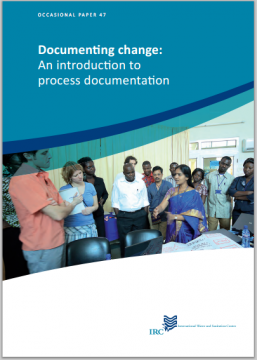Documenting Change: An Introduction to Process Documentation


Introduction
“Planned intervention is an on‐going, socially constructed and negotiated process, not simply the execution of an already specified plan of action with predictable outcomes” (Long, 1995, p. 127).
Development work involves complex processes of social change and institutional transformation. Most often, the road followed is not straight oftentimes ruts, bumps, curves, dead‐ends, as well as new routes emerge along the way. Change is a non‐linear and unpredictable process.
Planned recurrent documentation and reflection during the course of an intervention – rather than at its completion – can help surface unforeseen issues, providing new insights into initiatives (also referred to in here as interventions). By recording stories of change about how things were done, what worked, and what did not, individuals involved in an intervention can learn, improve upon the intervention and share lessons with others. Understanding this process and adapting development interventions based on findings is crucial to achieving broad development goals more realistically and effectively.
Process Documentation
The objective of the featured article is to provide insights into what process documentation is, how it should be carried out and who should undertake it, using the experiences gained from current and recent programmes.
The term ‘process documentation’ has been used for some time to describe documentation approaches within project interventions. Process documentation is generally understood to be a term for using a set of tools for documentation and learning during the course of development interventions. It will include attempts to capture the factors (expected or otherwise) that affect the change process that the intervention is aimed at.
The main steps in process documentation:
Developing a structured and focused way of capturing the change process requires taking several steps. These include:
– Identifying the theory of change and operational assumptions behind the initiative.
– Capturing systematically information related to the theory of change and operational assumptions.
– Organising information in such a way that stakeholders can reflect and learn about the process.
– Analysing information by looking at common themes, trends and patterns and placing findings in the context of the project and the project’s theory of change.
– Disseminating information in a format (and at a pace) that is useful and comprehensible.
– Using the findings to improve the approach, strategy and adjust theory/assumptions about change.
Benefits of process documentation:
Effective and well‐planned process documentation can contribute to development interventions in many ways. Process documentation can have many aims and benefits. It can:
– Help project staff and other stakeholders track meaningful events in their project, discern more accurately what is happening, how it is happening and why it is happening.
– Set a project in its local context and the reality of people’s lives.
– Stimulate public debate about key obstacles and opportunities for change.
– Improve the quality and impact of a project. Contribute to the collection of qualitative information to fill out the story behind the figures.
– Encourage learning from mistakes and create opportunities to celebrate impact.
– Challenge assumptions.
– Lead to closer relationships with stakeholders and give them a voice.
Lessons Learned and Good Practice
Examples from the various programmes described in the report illustrate that process documentation can be conceptualised in different ways to serve different purposes. It can help to articulate deep‐rooted structures, traditions, beliefs and attitudes that may hamper change, give project stakeholders’ stories a more prominent place in the project, provide stories that give more descriptive information about the results being monitored, enable learning and informal monitoring ‐ on the basis of interviews, observations in meetings and other consciously created reflection moments ‐ or capture trends and relations between project activities and results.
From the analysis in this report, the authors feel that seven lessons can be identified:
1. Process documentation provides a structured, focused way of capturing the change process.
2. The prime objective of process documentation is learning during the course of a project. However, institutionalising learning and reflection is a challenge and resources for this are often spent on other activities.
3. Process documentation requires time, skills and resources.
4. Process documentation is not a stand‐alone activity and must be supported by project team(s).
5. Developing a clear process documentation plan at the start of the project can help clarify focus, aims and responsibilities, which helps make process documentation useful and systematic.
6. Resource allocation for process documentation, as well as the intensity of support provided, have consequences for the kinds of outputs that process documentation is aiming or can be expected to produce.
7. The importance of establishing and maintaining trust and the politics of documentation should not be underestimated.
Suggested citation
da Silva Wells, C., Le Borgne, E., Dickinson, N. and de Jong, D., 2011. Documenting change: an introduction to process documentation. (Occasional Paper 47) [online] The Hague, The Netherlands: IRC International Water and Sanitation Centre (Published October 2011).
(0) Comments
There is no content